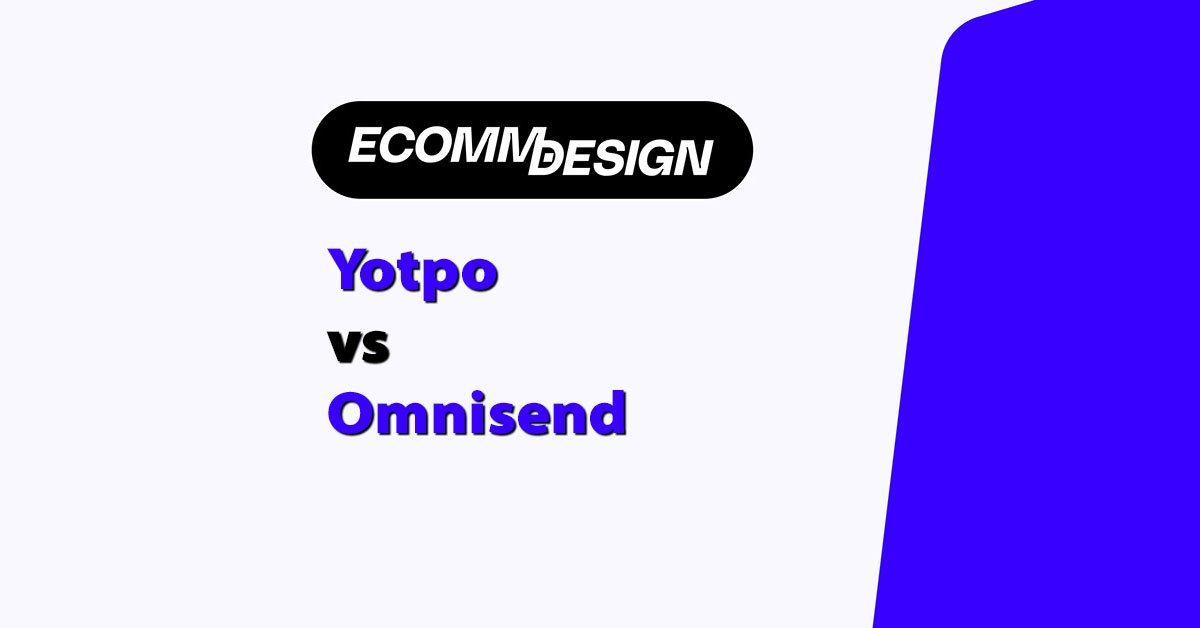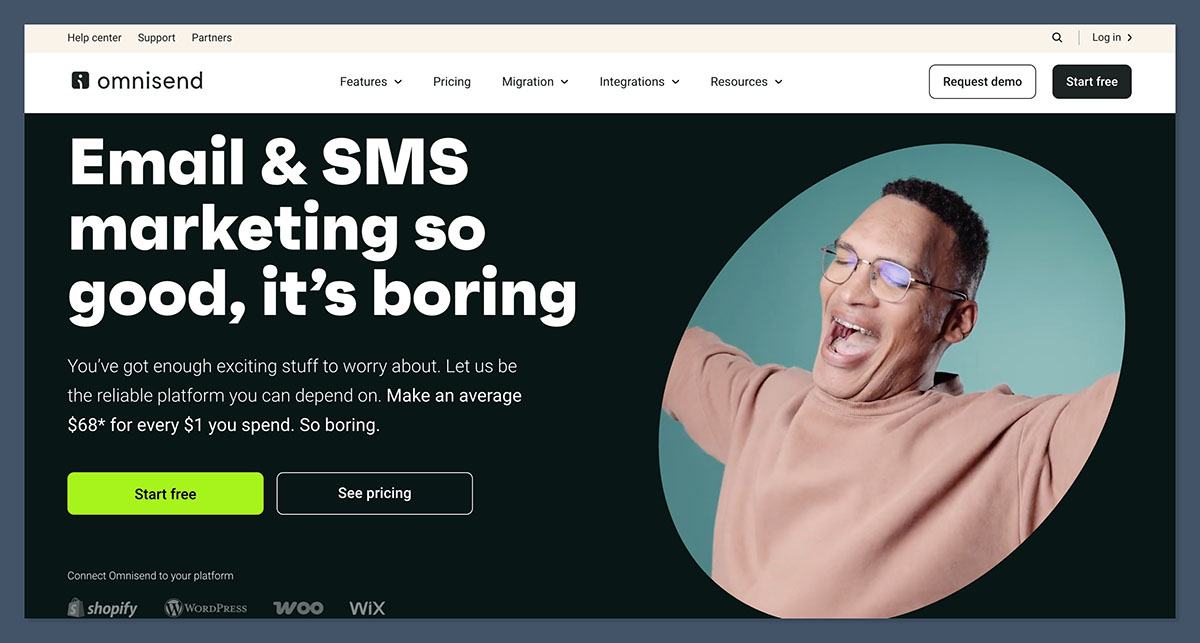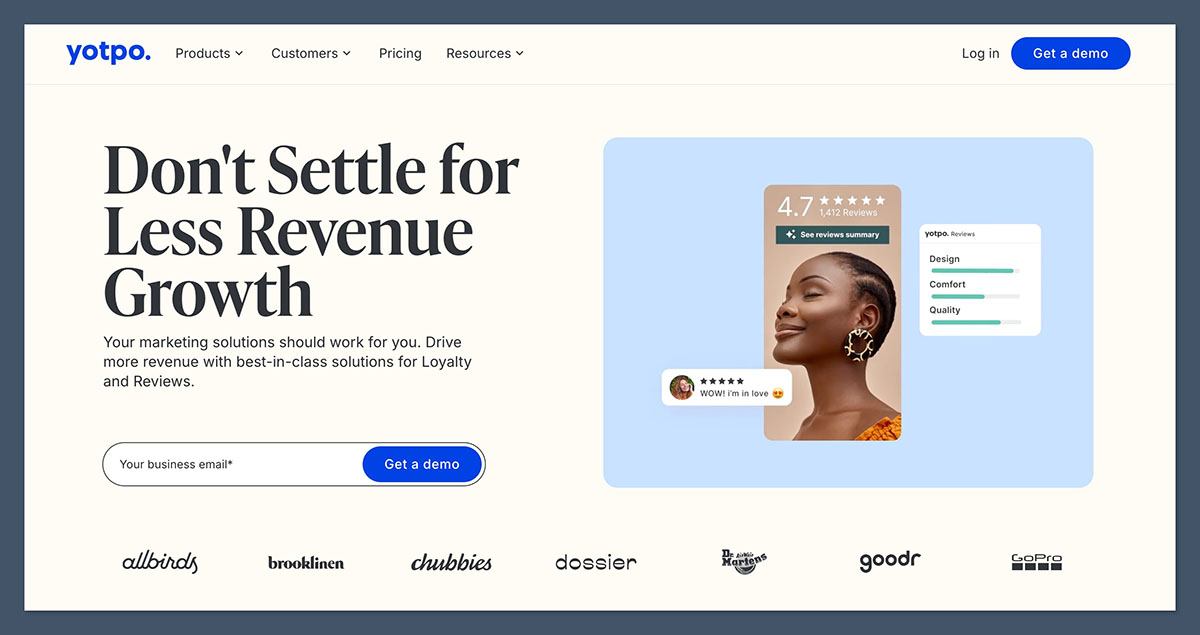
Yotpo and Omnisend are two of the most popular ecommerce tools, but they serve very different purposes.
We’ve spent over 100 hours testing and analyzing these platforms to help you decide which one is best for growing your online store.
As a result of our testing, Omnisend is the better option if you want to scale your ecommerce marketing quickly.
It’s easier to use, offers better value for money, and delivers faster results through built-in email and SMS automation.
Yotpo vs Omnisend: Quick Verdict
Omnisend – Best overall for ecommerce marketing automation and revenue growth
Yotpo – Best for loyalty, reviews, and increasing customer retention
In this guide, I’ll walk you through exactly how Yotpo and Omnisend compare, covering pricing, marketing features, reviews and loyalty tools, ease of use, and more.
Updated: August 20, 2025
Quick Comparison: Yotpo vs Omnisend
Use this comparison table to quickly see how the two tools stack up:
| Feature | Yotpo | Omnisend |
|---|---|---|
| Email marketing | No (requires integration) | Yes (built-in) |
| SMS marketing | Yes (via SMSBump) | Yes (built-in) |
| Reviews & ratings | Yes | No |
| Loyalty programs | Yes | No |
| Referral programs | Yes | No |
| Popups and forms | Basic | Advanced |
| Pricing | Expensive and modular | Affordable, flat-rate plans |
| Best for | Customer retention and loyalty | Fast email/SMS revenue generation |
| Free plan available? | Yes | Yes |
| Setup difficulty | Moderate to complex | Beginner-friendly |
Best for Pricing: Omnisend

If you’re looking for the best value tool to grow your ecommerce business, Omnisend wins this round.
Both platforms offer free plans, but Yotpo’s pricing quickly scales depending on which modules you need — and that can get expensive fast.
Yotpo Pricing
Yotpo’s pricing is split across individual products like Reviews, Loyalty, Referrals, and SMSBump. While each product offers a free tier, advanced features require multiple paid subscriptions.
Here’s a general breakdown:
- Reviews: Free up to 50 orders/month, then starts at $15/month
- Loyalty & Referrals: Free up to 100 orders/month, then from $29/month
- SMSBump: Pay-as-you-go model ($0.0149/SMS in the US)
- Visual UGC tools: Custom pricing only
If you want all the features, you’re looking at $200–$500/month or more once you scale.
What makes Yotpo tricky from a budgeting standpoint is the lack of bundle pricing.
You can’t access everything under one plan, so scaling up means managing multiple subscriptions — one for reviews, another for loyalty, and so on.
This can be difficult to forecast and manage, especially for smaller teams trying to keep tech stacks simple.
Omnisend Pricing
Omnisend’s plans are far simpler and more affordable for small and medium-sized ecommerce stores.
- Free Plan: 250 contacts, 500 emails/month, 60 SMS
- Standard Plan: $16/month for up to 500 contacts, unlimited emails
- Pro Plan: $59/month, includes advanced features and 3,933 SMS credits
Omnisend also offers 24/7 live chat support on all plans — including the free one.
Another big benefit with Omnisend is that it scales predictably. You only pay more when your contact list grows, and you don’t need to install separate apps or manage different modules.
This flat-rate approach makes budgeting easier, and you still get access to powerful tools without constantly upgrading.
The Winner: Omnisend
Omnisend offers more marketing features out of the box and a better value for money. Its pricing structure is easy to understand and scales with you.
Best for Reviews and Loyalty: Yotpo

This is where Yotpo clearly wins.
If your priority is building trust through product reviews or increasing repeat purchases with loyalty programs, Yotpo is one of the best platforms available.
What Yotpo Offers
- Product reviews and ratings that display on product pages, collections, and Google Shopping
- Loyalty and rewards programs that reward purchases, referrals, and social shares
- Referral programs built to reward word-of-mouth marketing
- Photo and video UGC that integrates directly into your storefront
These tools help increase trust and retention, which is critical if you’re running a brand in a competitive niche like fashion, beauty, or supplements.
Yotpo also gives you more control over how reviews appear on your storefront.
You can request customer photos, highlight top reviews, filter based on product variants, and display content-rich widgets on landing pages. This flexibility helps you build trust at every step of the buyer journey.
What Omnisend Offers
Omnisend doesn’t offer product reviews or loyalty tools. You’ll need to integrate with third-party tools like Stamped.io or Smile.io if those are important to your brand.
While Omnisend does support integration with these platforms, it’s not a seamless experience.
You won’t find built-in analytics for reviews or loyalty, which means additional setup and data syncing. For brands heavily focused on social proof and retention, this makes Omnisend less of an all-in-one option.
The Winner: Yotpo
Yotpo is the better tool for retention and building social proof. It’s not cheap, but it’s extremely effective if you can afford it.
Best for Email & SMS Marketing: Omnisend
Email and SMS marketing is the foundation of ecommerce growth — and Omnisend outperforms Yotpo in this category with a built-in solution that works right out of the box.
Omnisend Features
- Drag-and-drop email builder with dozens of templates
- Pre-built automation workflows like welcome series, cart abandonment, and win-back flows
- Unified email and SMS campaigns in the same automation
- Behavior-based segmentation (e.g., purchase history, product viewed)
- Revenue attribution dashboards to track ROI directly
Omnisend makes it simple to create complex automations without needing outside tools. This saves time and money while increasing conversions.
One standout feature is how Omnisend lets you combine SMS and email in a single workflow.
You can create a cart recovery flow that sends a reminder email followed by a last-minute SMS.
This multichannel approach increases engagement rates and drives higher revenue — especially during product launches and sales.
Yotpo (SMSBump)
While Yotpo’s SMSBump is a strong standalone SMS platform, it doesn’t include native email marketing.
If you want to run both email and SMS campaigns, you’ll need to integrate with another platform like Klaviyo — which adds cost and complexity.
Yotpo’s SMSBump does allow for automation and compliance features like quiet hours, consent tracking, and custom flows.
However, because email isn’t included, your customer messaging strategy can become fragmented across platforms — especially when trying to coordinate promotions or flows.
The Winner: Omnisend
Omnisend gives you everything you need for multichannel marketing in one place, including robust email and SMS automation.
Easiest to Use: Omnisend
When I tested both platforms, Omnisend was far easier to set up and start using.
Getting Started with Omnisend
Omnisend’s onboarding is smooth and beginner-friendly. I was able to:
- Import products and customer data from Shopify in under 5 minutes
- Set up an abandoned cart flow in 10 minutes
- Launch a welcome email sequence before lunch
The visual automation builder is intuitive, and the UI is clean and distraction-free. If you’ve never used a marketing platform before, you’ll still feel confident using Omnisend.
Omnisend also provides step-by-step onboarding checklists that guide you through campaign creation, segmentation, and list growth.
It’s not just about launching — it’s about optimizing, and Omnisend gives you a clear roadmap from day one.
Getting Started with Yotpo
Yotpo’s setup process is more technical and modular.
If you want to use multiple features (like reviews, loyalty, and SMS), you’ll need to install several apps and configure each one separately.
- Reviews setup takes time to customize and match your theme
- Loyalty requires defining multiple rules and reward logic
- Integrating SMS requires consent capture and compliance steps
Yotpo offers onboarding support, but the learning curve is noticeable — especially if you’re managing everything yourself.
In testing, I found Yotpo’s backend to be harder to navigate.
Switching between different tools (like Reviews and Loyalty) felt disjointed, and I had to refer to documentation often. It’s manageable, but not the most user-friendly platform out there.
The Winner: Omnisend
Omnisend is faster to set up, easier to use, and offers a better experience for solo founders and small teams.
Best for Reporting and ROI Tracking: Omnisend
Both platforms offer reporting, but Omnisend makes it much easier to track revenue and optimize performance.
Omnisend Analytics
Every campaign, automation, and channel is linked to revenue in Omnisend. You can see:
- Revenue per email or SMS campaign
- Conversion rates on flows (like abandoned cart series)
- Subscriber growth and behavior over time
- Detailed A/B testing results
This lets you clearly see what’s driving results — without needing third-party tools.
You can also track advanced metrics like click maps, device performance, and customer lifetime value by segment.
This level of insight helps marketers double down on what’s working and adjust quickly when performance drops.
Yotpo Analytics
Yotpo offers reporting across Reviews, Loyalty, and SMS, but it’s segmented by product.
You’ll have to jump between dashboards to understand how each channel is performing. Revenue attribution is available, but less comprehensive unless you’re on an enterprise plan.
Yotpo does offer integrations with analytics tools like Google Analytics and Shopify reports, but tying everything together requires more manual effort.
It’s not ideal if you’re looking for a centralized view of your marketing performance.
The Winner: Omnisend
Omnisend provides a complete picture of what’s working — without needing to leave the platform or upgrade to expensive tiers.
Best for Customer Support: Omnisend
Both platforms offer customer support, but Omnisend delivers a better experience, especially on lower-tier plans.
Omnisend Support
- 24/7 live chat on all plans, including free
- Helpful and fast responses (under 10 minutes)
- Extensive knowledge base with video walkthroughs
Omnisend also provides in-dashboard tips and suggestions as you build automations or create campaigns.
These proactive nudges help you avoid mistakes and implement best practices faster, which is helpful for users who are new to email and SMS marketing.
Yotpo Support
- Email and chat support, but limited availability on lower plans
- Faster support available only to premium or enterprise customers
- Support documentation is helpful, but spread across different product areas
Yotpo’s support is generally helpful once you reach them, but getting priority attention requires upgrading to higher plans. This creates a noticeable gap in response quality depending on how much you’re spending.
The Winner: Omnisend
Omnisend offers better support for small businesses and doesn’t hide live chat behind a paywall.
Final Verdict: Omnisend Is the Better All-in-One Marketing Tool
Both Yotpo and Omnisend are powerful tools — but they serve different purposes. If you’re focused on retention and already have a strong customer base, Yotpo can help build loyalty and trust.
But if you’re just getting started or want faster growth from email and SMS, Omnisend is the better overall platform.
Here’s a quick recap:
| Category | Winner |
|---|---|
| Pricing | Omnisend |
| Reviews & Loyalty | Yotpo |
| Email & SMS Marketing | Omnisend |
| Ease of Use | Omnisend |
| ROI Tracking | Omnisend |
| Support | Omnisend |
Best for fast growth and ease of use: Omnisend
Best for retention and loyalty: Yotpo
What really sets Omnisend apart is its ability to deliver quick wins for ecommerce brands.
Within hours of setting up, you can launch your first automated flows and start tracking real results.
For businesses trying to scale with limited resources, Omnisend helps streamline workflows and generate sales without the added complexity of stacking multiple tools.
If you’re choosing just one tool to get started with ecommerce marketing, I recommend signing up for Omnisend’s free plan and testing your first automated campaign. You’ll be able to see results within days — not weeks.






